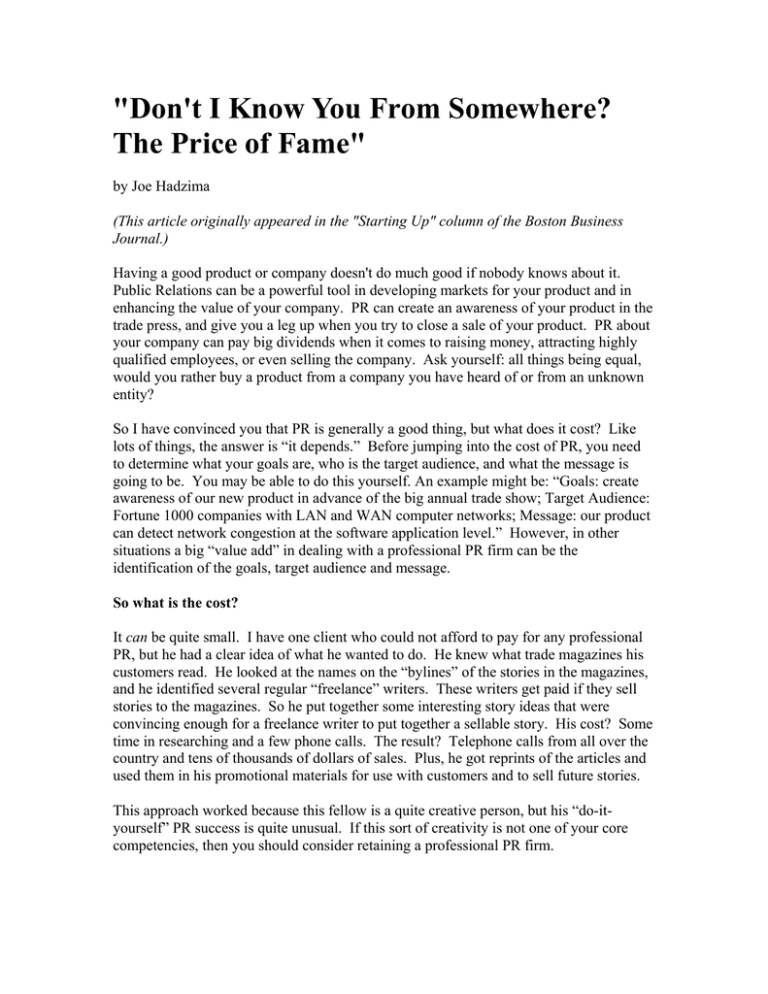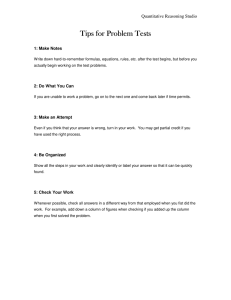"Don't I Know You From Somewhere? The Price of Fame"
advertisement

"Don't I Know You From Somewhere? The Price of Fame" by Joe Hadzima (This article originally appeared in the "Starting Up" column of the Boston Business Journal.) Having a good product or company doesn't do much good if nobody knows about it. Public Relations can be a powerful tool in developing markets for your product and in enhancing the value of your company. PR can create an awareness of your product in the trade press, and give you a leg up when you try to close a sale of your product. PR about your company can pay big dividends when it comes to raising money, attracting highly qualified employees, or even selling the company. Ask yourself: all things being equal, would you rather buy a product from a company you have heard of or from an unknown entity? So I have convinced you that PR is generally a good thing, but what does it cost? Like lots of things, the answer is “it depends.” Before jumping into the cost of PR, you need to determine what your goals are, who is the target audience, and what the message is going to be. You may be able to do this yourself. An example might be: “Goals: create awareness of our new product in advance of the big annual trade show; Target Audience: Fortune 1000 companies with LAN and WAN computer networks; Message: our product can detect network congestion at the software application level.” However, in other situations a big “value add” in dealing with a professional PR firm can be the identification of the goals, target audience and message. So what is the cost? It can be quite small. I have one client who could not afford to pay for any professional PR, but he had a clear idea of what he wanted to do. He knew what trade magazines his customers read. He looked at the names on the “bylines” of the stories in the magazines, and he identified several regular “freelance” writers. These writers get paid if they sell stories to the magazines. So he put together some interesting story ideas that were convincing enough for a freelance writer to put together a sellable story. His cost? Some time in researching and a few phone calls. The result? Telephone calls from all over the country and tens of thousands of dollars of sales. Plus, he got reprints of the articles and used them in his promotional materials for use with customers and to sell future stories. This approach worked because this fellow is a quite creative person, but his “do-ityourself” PR success is quite unusual. If this sort of creativity is not one of your core competencies, then you should consider retaining a professional PR firm. PR persons I have talked to tell me that there are two facts of life in the public relations business: clients want results NOW, and they don't want to pay a fortune for those results. Companies hire PR firms to make good things happen for them as costeffectively as possible. The problem is that “good things” just don't happen by themselves. Positive, extensive, and regular media coverage is almost never an accident for publicly traded companies and never-ever is an accident for privately held companies. How do you determine a “fair market value” for PR? The problem is that effective public relations is a process that evolves over time. Time is money. How much time? How much money? For an aggressive PR program, expect to pay as much as $10,000 per month or more. Many firms prefer to work with a 12-month contract with a 60-day cancellation clause. There are more than a few Boston-area software companies, for example, that are paying $10,000 per month for PR. The “average” PR expense across most industries is more likely to be in the $5,000 to $6,000 per month range. How is the amount calculated? One approach is “billable hours.” Once you and the PR firm determine what needs to be accomplished, the PR firm then will estimate the number of hours necessary to complete the job, assign one or more professionals to the account, and bill each at a particular hourly rate against the number of hours spent on the account. Usual and customary billing rates are: PR firm president/owner/principal: $250-$300/hr.; VP-level: $175/hr.; Senior Account Executive: $125/hr.; junior AE: $75/hr.; clerical support: $35/hr. You should insist on a maximum monthly fee under this approach. A variation on this approach is a retainer. Again, the PR needs are determined, the PR firm assigns personnel, and a flat, monthly fee is agreed upon—expenses are nearly always billed separately. With this approach, the company knows what to expect each month in PR fees. Another approach which I have seen used is a combination of cash and stock. Consider a particular PR program which is estimated to be $6,000 per month over a 12-month period. The company is emerging, and while it desperately needs extensive, regular, and favorable publicity to drive sales, assure a full and fair market value for its stock, and attract top-notch employees, it cannot afford or chooses not to pay $6,000 in cash per month. An alternative might be to offer the PR firm $3,500 per month in cash and stock options on 15,000 shares accruing at 1,250 shares per month over the 12 months. Remember: no reputable PR firm will ever “guarantee” results. The PR firm and you should mutually agree on the goals of the effort, and then measure results against those goals. Be sure to look at the track record of the PR firm. Can the firm show you that it has orchestrated the kinds of PR accomplishments you desire? While there can be no guarantees that the PR firm can make the same great results happen for you, the fact is that a successful PR firm track record at least “guarantees” your company that if your PR goals are theoretically achievable, then this particular PR firm stands an exceptional chance to achieve those goals, given its similarly successful performance for others in the past. Finally, be prepared to be patient—effective PR is a process which evolves over time. My thanks to a variety of people for input to this column, especially Ron Trahan of Ronald Trahan Associates, Inc. in Natick, Massachusetts. DISCLAIMER: This column is designed to give the reader an overview of a topic and is not intended to constitute legal advice as to any particular fact situation. In addition, laws and their interpretations change over time and the contents of this column may not reflect these changes. The reader is advised to consult competent legal counsel as to his or her particular situation.

